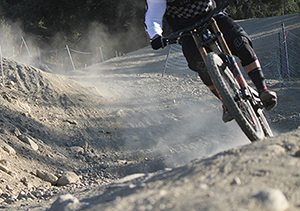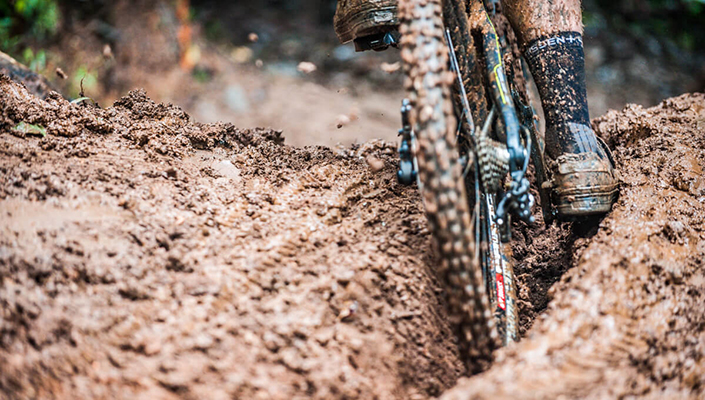At the beginning and towards the end of the year, conditions of your local trails may be rough. A season of riding, or a season of neglect, may have left your favorite ribbons of green and brown a mess of axle-deep ruts and washed out corners. Ruts can sneak up on you in the shadows or be waiting around blind corners, and they are often the cause of incredibly dangerous crashes. No matter what your mountain bike discipline – from DH to AM, XC, or even CX – BikeRoar is here to help you navigate these dangerous trail ruts.
Know the conditions

The first thing you want to do is consider the conditions you're likely to encounter to prepare your mind and eyes for the trail. Was it just raining hard? Has it been dry for months? Does water naturally run down the trails? Was there just a race on your trails?
Heavy rains can cause trail erosion, which is one of the main causes of deep and dangerous ruts. Water always finds the easiest path, so a trickle down a trail can turn into a deep gouge in no time at all. Be aware of how your trails may change after heavy rainfall. It’s always good to consult your local trail organization on the conditions before you ride.
WARNING!
In addition to advising you of trail conditions, your local trail organization may advise you to not ride a muddy trail. That's because riding a wet, soft trail can add to trail damage and ruts, creating more rideability and trail maintenance issues. The advice will depend on your area, the amount of rain, and the soil's ability to handle water, but it's good to ask or make the responsible call yourself.
A big race can also dramatically change your trails, as hundreds of racers dragging their rear tires can blow out an entire trail in no time flat. My local trails saw both Singletrack-6 and the BC Enduro Series roll through on consecutive weekends, and the 600-some racers definitely left their mark. If it has been a while since you’ve ridden a particular trail, consult your trail organization, canvass your friends, or check a cycling forum or group to update yourself on current conditions. This extra bit of research could save you from a nasty crash.
Okay, let’s get to it. If you’re riding a trail and there are significant ruts, here are a few tricks and bits of know-how that will help you navigate them safely.
Linear ruts

Linear ruts are the ones often caused by running water erosion and/or trail abuse – they run linearly down the trail. They are usually created in steep sections of straight trail, as water moves down the hill rather than pooling. Riders also often drag their rear brakes during steep sections and this can contribute to the rutting.
If you ride into the ruts, commit to riding them all the way out. Getting out of ruts is usually more difficult than riding in them. Stay out of ruts that are axle-deep or deeper, otherwise you run the risk of clipping your lowers (bottom of your fork) and being sent to your face. When you elect to ride beside the ruts, keep in mind they usually go between roots and rocks, so prepare for other potential challenges in your way.
If you decide to get out of a rut, look for a good place to do it – ideally a spot that is shallower and at a consistent depth. Slow down and point your wheel to the side. This should be a decisive movement and at a sufficiently sharp angle so that you roll out of the rut rather than just hit the wall with the side of your tire and stay trapped, which could lead to a tip over. As your skills improve, you can combine movement with a front wheel lift or hop to clear out of the rut.
RELATED: How to ride slippery roots
Corner ruts

Like linear ruts, corner ruts are usually made from the combination of water erosion and people dragging their brakes, only they turn with the corner and can be extremely dangerous, as you may not see them when you first enter your turn. When people corner correctly, they will kind of smash into the apex of the turn, not just ride around it. This is where you will usually find the deepest part of the rut, so be prepared to take a higher line or a lower one to avoid it. If you're lucky to get a glimpse of the rut before you hit the corner, set up with a different trajectory to avoid it and keep your speed up. You could also play it safe and take it a bit slower in case there is a surprise waiting for you around the corner.
Brake ruts

Dreaded, unavoidable, bastards of late summer... Brake ruts appear over time where people apply their brakes. They are essentially the same as the washboard roads that rattle the fillings out of your mouth and cause random parts to fall off your truck. Brake ruts can cause your hands and arms to lock up, as well as overload your suspension, leading to a bad crash. I know, they can seem so innocent, but they can render every millimeter of your suspension completely useless.
The best way to deal with brake ruts is to allow your arms and knees to flex; be as supple as possible to absorb the impacts. You can also adjust your suspension so your high-speed compression is capable of handling the sharp little bumps. If you don’t have these controls on your suspension, then now’s a great time to upgrade! Carbon handlebars also alleviate the jarring impacts your hands and arms take from brake rutted trails; they are worth considering.
Deep mud ruts
Mud ruts can be deceiving; they may trick you by looking like they are soft, pliable, and easy to just squish your way through, however, that is rarely the case. These ruts are often firm underneath and any slight deviation from their trough can lead to instant slip. It's easy to forget that the deep mud is going to completely pack your tire, making it virtually impossible to get any grip. Your tires get turned into big, bald, rotating masses of forest snot. This is why you crash - your line is ever so slightly off, your tires are packed with mud, and you have no hope at all.

To survive this big mess you have to keep it simple and take it easy. You want to anticipate the differences between the hard ground and soft mud on top. Make slight changes to your line with your body and not your bike. Allow your bike to float through the mud with slack elbows and knees. Head into the mud ruts slow and do not hit your brakes while making your way through them, as doing so would cause you to slide. Keeping it simple, slow, and in control is the best way to conquer deep mud ruts.
Ruts are not usually fun, but you're almost certain to encounter them. Learn how to ride them and consider them an added element of technicality to test your skill on your usual rides. Take the time to understand trail conditions before you ride to put yourself in the best position to handle a rutted out ride.

RELATED ARTICLE:
How to ride gnarly steeps
Tips to conquering your fears and mastering those steep, gnarly, mountain bike trail sections. Go from frozen in fear to confident, fast, and flowing... READ MORE

RELATED ARTICLE:
How to save energy while mountain biking
In mountain biking there are plenty of opportunities to waste energy and wear yourself down. Our mountain bike expert sheds some light on ways to minimize energy loss and ride efficiently... READ MORE



